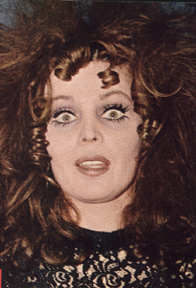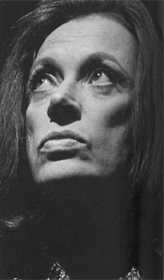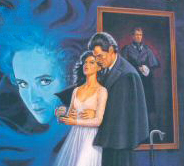| Part Four:
More Monsters
 To help lessen the strain on Jonathan Frid, other monsters were added to the storyline. Robert Rodan played Adam, a Frankenstein-inspired creature stitched together from cadavers; stage actress Marie Wallace (pictured right) was brought on to portray his bride, Eve. Don Briscoe played a vampire, then the vampire's twin, a werewolf. Then David Selby was hired to play Quentin Collins, and the storyline shifted to 1897 (and back again) to tell his tale. Briscoe and Selby (along with Roger Davis, Christopher Pennock, Michael Stroka and David Henesy) were often profiled in teen magazines like 16 and Tiger Beat. To help lessen the strain on Jonathan Frid, other monsters were added to the storyline. Robert Rodan played Adam, a Frankenstein-inspired creature stitched together from cadavers; stage actress Marie Wallace (pictured right) was brought on to portray his bride, Eve. Don Briscoe played a vampire, then the vampire's twin, a werewolf. Then David Selby was hired to play Quentin Collins, and the storyline shifted to 1897 (and back again) to tell his tale. Briscoe and Selby (along with Roger Davis, Christopher Pennock, Michael Stroka and David Henesy) were often profiled in teen magazines like 16 and Tiger Beat.
By 1968, Dark Shadows evolved into a pop cultural phenomenon. In costume as Barnabas, Jonathan made personal appearances everywhere from the White House to the kids' show Bozo's Bigtop. Games, toys, puzzles, gumcards, and more memorabilia was marketed. (Read more about the collectibles)
At the peak of public frenzy, Dan Curtis decided to move the story of the Collins Family to the big screen. He sold MGM on the idea, and set out to retell the basic tale already laid out on TV, which had propelled the show to such success: the unleashing of vampire Barnabas Collins. READ MORE about House of Dark Shadows. The End?
After nearly five years overseeing stories of time travel and monsters, Dan Curtis decided he was ready for new challenges -- and that he didn't want to hand over the Dark Shadows reins to anyone else. With storylines growing convoluted, fans were starting to drift away from the show, so ratings were again declining. Adding a complication, Jonathan Frid insisted on being cast as another character besides Barnabas. His Bramwell Collins was a lackluster, fangless hero who didn't inspire the same audience passion the vampire had garnered. It all added up to the end of the remarkable soap opera's run.
The New York Post was one of the first to deliver sad news to fans: "After some five seasons on daytime TV, the ABC vampire series, Dark Shadows, apparently is running out of blood in the Nielsen ratings," the newspaper reported on March 3, 1971. Taking over the DS timeslot would be a new version of the old gameshow Password.
On Thursday, March 25, 1971, a farewell party was held at the ABC-TV studio at 433 West 53rd Street in New York. Cast members past and present gathered to toast the end of the series. The final episode aired April 2.
Thayer David summed up the cast members' mixed feeling about the show's demise: "When one is on a roller coaster, one prays for it to end," he said. "But then the coaster stops, and one gets off and suddenly the world seems duller and sadder somehow."
But just like the various creatures on the show, Dark Shadows didn't remain dead for long. For one thing, there was another movie to make.
 Shortly before the final few episodes of Dark Shadows were taped, David Selby was rushed to the hospital with an attack of appendicitis, which kept him from appearing in those last shows. His costar Kate Jackson sat vigil by his hospital bed. "She just sat there, never saying a word," he told The New York Post years later. "It's the kind of thing you really appreciate at the time, and never forget later on." Soon after his recovery, the close friends played husband and wife in the film Night of Dark Shadows. Shortly before the final few episodes of Dark Shadows were taped, David Selby was rushed to the hospital with an attack of appendicitis, which kept him from appearing in those last shows. His costar Kate Jackson sat vigil by his hospital bed. "She just sat there, never saying a word," he told The New York Post years later. "It's the kind of thing you really appreciate at the time, and never forget later on." Soon after his recovery, the close friends played husband and wife in the film Night of Dark Shadows.
READ MORE about Night of Dark Shadows Syndication
Five years after going off the air, Dark Shadows found an audience again, in syndication. It was offered in a package, paired with another hugely successful, quirky soap: Norman Lear's Mary Hartman, Mary Hartman. According to Variety, distributor Worldvision told stations that DS "naturally compliments Hartman and can make a major market independent station strong from 11 p.m. to midnight." According to the Variety article, Worldvision had tried to syndicate DS in 1971, but there wasn't sufficient interest to over the residual costs, which were high due to the large cast. When DS was syndicated in the New York market, in the 1980s, The Village Voice gave it a backhanded recommendation. Citing "scenery-chewing performances, flubbed musical cues, and cockamamie camera work," the Voice reviewer, Jim Farber, said it was fun to watch. He especially enjoyed Grayson Hall, who, he said, "registers 16 facial expressions per emotion." Reruns of Dark Shadows are not currently being aired, but episodes are available on VHS and DVD.  DS was revived in 1991. An updated version with an all-new cast lasted one season on NBC. And in 2004, the Barnabas lived again, in another reimagining of the classic story on the WB. Click here to read about both revivals. DS was revived in 1991. An updated version with an all-new cast lasted one season on NBC. And in 2004, the Barnabas lived again, in another reimagining of the classic story on the WB. Click here to read about both revivals.
Fans keep the flame burning
Trekkies who wear fake pointed ears and speak Klingon may get most of the press attention, but Dark Shadows fans are just as loyal. The first Dark Shadows convention, called ShadowCon I, was held in July 1977, in Los Angeles. None of the actors attended this first fan gathering, but the following year, July 1 to 4, 1978, Lara Parker, Christopher Pennock, John Karlen, and Jerry Lacy were part of ShadowCon II at the Los Angeles Marriott Hotel. In 1983, the first Dark Shadows Festival took place, in Newark, New Jersey. The now-annual event draws thousands of fans each year. Click here to read more about the Dark Shadows Festivals. |